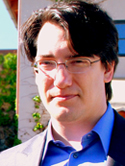





Biography of Dr. Christopher Poletto:
Growing up in Oklahoma, young Christopher Poletto was interested in science and engineering from an early age. From the age of 5, he was taking courses at the local science museum in electronics and the biological sciences. At age 8, he began volunteer teaching courses in basic chemistry, paper making, and herpetology. By 16 he was running the biology department and exploration room. Working at the science museum afforded him the rare opportunity to have first hand exhibit design and presentation experience as well as the unique opportunity to refurbish the Apollo XI test command module. By age 18 he had already lectured to over half a million visitors to the museum and was very comfortable conversing on a wide variety of scientific topics and founded two Explorer posts to foster scientific exploration among other teens.
Christopher's love of software development also started early, when he began commercial programming at age 14. As one of the initial programmers of the first TRS color computer, his program demos were visible in almost all Radio Shack computer stores in the country.
Christopher's passion for the creation of devices to interface with the human body stems from his sophomore year in high school, when he had the rare opportunity to participate in a local professor's efforts to develop the first artificial liver. His responsibility for formulating and solving many of the differential equations that governed the device also solidified his love of the practical application of math.
Christopher attended Rice University to pursue a degree in Robotics engineering. The custom degree was a dual major of electrical and mechanical engineering. While at Rice, he took advantage of opportunities to conduct undergraduate research and design, programming the first computational model of the human cardiac Purkinje fiber, designing and building robots to aid quadriplegics, electrical stimulators to resolve foot-drop in stroke victims, and a robot to automate the processing of amniocentesis cultures, among others.
Following graduation, Christopher's life took an unexpected turn when he took a job as a field engineer in the oil business in West Africa. Following training in Italy, he traveled around West Africa for three years, leading teams engaged in high tech services under extreme conditions. Notable accomplishments included having the highest revenues and best safety record in Africa. The experience was invaluable in providing leadership experience and the ability to very rapidly solve problems with severely constrained resources. The position also afforded him the opportunity to learn French and Italian.
Once he had made enough money to pay for graduate school, Christopher returned to his chosen career path, obtaining masters and PhD degrees in biomedical engineering from Case Western Reserve University in the world's leading program for neuroprosthetics training. He focused on the stimulation of sensory nerves to provide sensory substitution and sensory feedback for neuroprosthetics systems. His research addressed current issues in sensory psychophysics, neuroprosthetics system design, electrotactile stimulation, and functional electrical stimulation. His PhD program included honing his anatomy and physiology skills at the associated medical school. At the time, Christopher was the only student able to maintain a 4.0 GPA throughout his graduate program, despite the fact that he was simultaneously running an international software company in an unrelated discipline.
Following graduate school, Dr. Poletto accepted a position as a staff research engineer at the National Institute for Neurological Diseases and Stroke (NINDS), an institute within the National Institutes of Health (NIH). Serving under the world's leading expert on speech and swallowing pathology research, he was responsible for scientific protocol design, design and construction of all custom hardware and software, training of the post doctoral fellows, and incorporating new technologies into the research program. This incredible research environment allowed him to gain experience with a wide range of data acquisition technologies, including functional and anatomical MRI, magnetoencephalography (MEG), electroencelphalography (EEG), functional electrical stimulation (FES), electrictromyography (EMG), acoustic analysis, neural stimulation, video motion analysis, 3-D articulography, and videoradiography.
As his academic career progressed, Dr. Poletto became convinced that the key to capitalizing on research breakthroughs and having them benefit patients lay with industry. He therefore decided to join the world's leading medical device company, Medtronic, as a principal research scientist. Although initially hired to work on a therapy for obesity, Dr. Poletto had the opportunity to work on many therapy projects and assume many roles while with Medtronic Neuromodulation. He was privileged to work as the lead scientist of cross functional teams addressing all phases of product commercialization from inception to post market study. Medtronic benefited from his leadership in successfully appealing adverse regulatory rulings in several geographies. He formulated global research and intellectual property strategies for therapies and technology areas. He was known as a thought leader and participated in several patent and research oversight boards.
As a creative visionary, he filed many patent applications in diverse fields related to electrode and lead design, surgical tool design, novel electrical field manipulations to improve stimulation selectivity, programming algorithms, electrical safety features, optogenetics, and pharmaceutical substances and therapy strategies, among others, winning awards for his creativity every quarter for the two years they were offered.
In 2011, Dr. Poletto left Medtronic when his position, along with 2000 others, was eliminated as part of a restructuring plan. He was invited to apply for other positions, but decided instead to form Neurovation, LLC in order to reach a wider variety of clients and have a greater impact on the neuromodulation industry and improve the lives of even more patients than could be reached through one company.